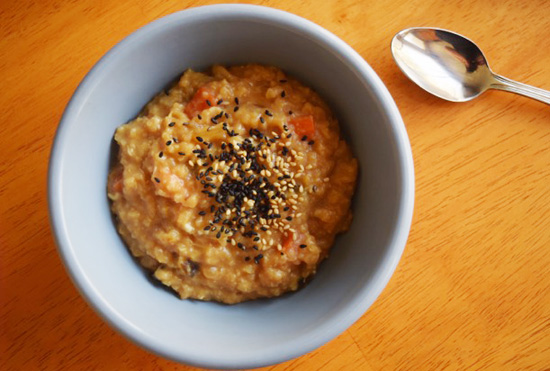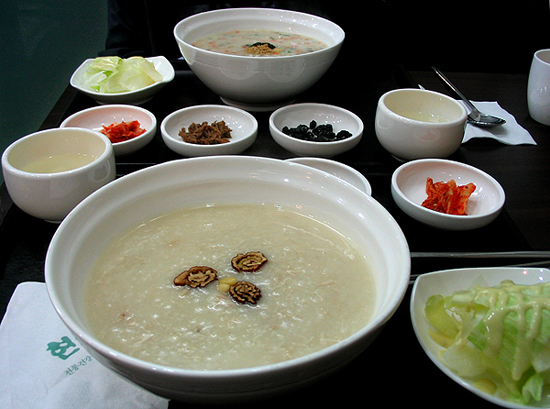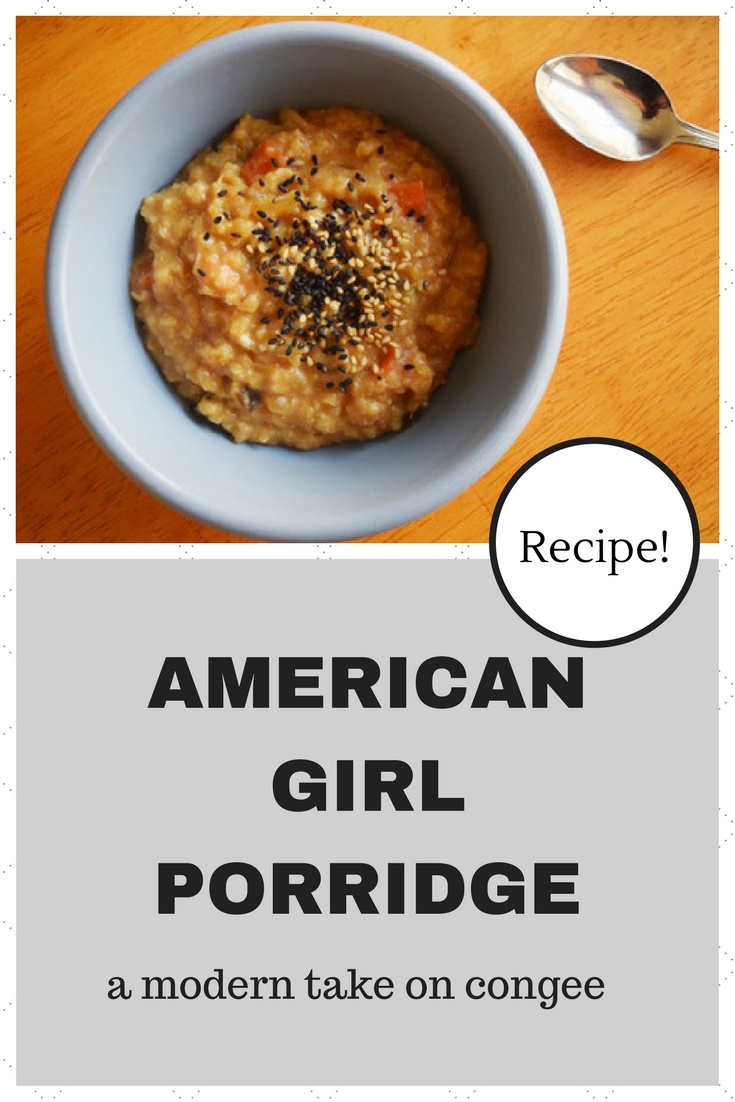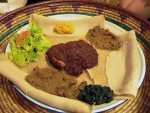Our writer details how to make healthy, delicious congee two ways: one traditional, one modern.

"American Girl Porridge," courtesy of Kimberly Nichols
My obsession with Asian porridges started years ago, when I found the cheaply made and nutritious bowl of ancient Chinese food called congee listed as one of the most nutritious foods in the world, according to my global herbalism textbook. It was noted that many a spry monk in the Himalayas considered three plain bowls of soupy rice a day the key to vibrant health and longevity. To that end, my herbal course suggested mixing up the plain, lovingly long-cooked rice and water recipe with a myriad of fun additions like herbs, spices, minced vegetables, and even miso. Then I started seeing various forms of Asian porridge pop up like wildflowers on the menus of the hottest Los Angeles restaurants as a comfort-food dessert with sweet curry or a warm breakfast bowl alternative to the typical American oatmeal.
When I mentioned my porridge fascination to my Japanese-Chinese boyfriend, he told me what I was calling porridge sounded a lot like his mother’s famous jook. That year during the holidays, he showed me what he meant by turning every spare bit of meat on a devoured turkey carcass (and rice, and carrots) into an unctuous, lush bowl of goodness.
I realized that I too had porridge in my Caucasian culinary lexicon. I grew up on slow-cooked oats with brown sugar, milk, and honey. I enjoyed an occasional tapioca pudding. But they were sweet and I was enjoying the savory in my newfound Asian varieties.
Congee, jook, porridge—regardless of its name, I was in love. What could be better than a bowl of savory soul-affirming goodness fortified by rice and endless options in flavoring? It was similar to, but dare I say better than, a traditional Jewish chicken soup. The key was in the preparation, which included hours of simmering and more liquid than would usually be used to make rice.

Korean juk, courtesy of Anna Lee/Flickr
I spent the past year or so researching Asian porridges as much as possible. My boyfriend had set a high bar with his jook, but I quickly discovered that most porridges were convenient and hardy solutions to empty pocketbooks or receptacles for scattered leftovers. Porridges existed to nourish the body economically, and because they were such staples in many homes, people carried a nostalgic love for this food.
I learned that Asian porridges came with many different names. At an exhibition at the Los Angeles Public Library that included the city’s historic menus, I spotted one menu that was essentially a long list of Asian immigrant porridges with titles, alternative spellings, and individual recipes, such as kanji (Tamil), juk (Korean), hsan byok (Burmese), bor bor (Khmer), and bubur ayam (Indonesia). I took a photo of the list and brought it home with me, determined to make every single variety.
The first one I tried was a recipe for chok, the Thai version. The recipe was written exactly as follows:
TRADITIONAL CHOK*
1. Wash rice 2-3 times.
2. Cook rice in water.
3. Cook garlic and ginger in skillet with oil.
4. Add ground pork, soy sauce, fish sauce.
5. Simmer one hour.
6. Raise heat, add two eggs, stirring and mixing well.
7. Garnish with fresh cilantro, fresh garlic, sliced ginger, and pickled garlic.
I spent an afternoon making this and guessing at the measurements. Knowing that porridges are supposed to be much thinner than actual steamed rice, I added three times the amount of water per serving of uncooked rice to the pot for the initial boil. I used two cloves of garlic and a dime of minced ginger, a half-pound of pork, and a tablespoon of both soy and fish sauces. I assumed that step five wanted me to throw the sautéed ground pork, soy sauce, fish sauce, garlic, and ginger mixture into the rice for the one-hour simmer, which I did. At the end of the hour, after stirring in the glorious yolky eggs and adding the garnishes atop to my taste, I had a savory, nose-piquing bowl of what I can describe only as the thing you would remember your mother making you while home with a cold—only 10 times more tummy-warming. It’s no wonder this dish carries with it a thousand years of history and so many adaptations. The Tupperware container of leftovers in the fridge sustained me through a week’s worth of lunches, but I could have easily eaten it for seven more days in a row.
Recently, I struck out on my own and concocted my own porridge in a more American vein, utilizing the principles and history of planetary congee. Here's how to make my version of nutritious, delicious congee:
AMERICAN GIRL PORRIDGE
Serves 2
1 Tbsp olive oil
½ carrot, peeled and diced
1/3 cup chopped yellow onion
½ cup organic, short-grain brown rice
1½ cups chicken stock or broth
1 inch grated, fresh ginger
1 tsp. fish sauce
1 tsp. soy sauce
2 inches kombu seaweed
1 egg
Sesame seeds
In large pot, sauté the carrot and onion in the olive oil until onion is transparent. Pour in the rice and sauté a minute or so until glistening. Add the chicken stock or broth and bring to a boil. Stir in the grated ginger, fish and soy sauces, and the kombu and turn down to a simmer. Cover with a lid; simmer for 45-60 minutes. Stir in egg at last minute before serving, and sprinkle with sesame seeds.
*Exact source material unknown; this recipe appeared in the 2013 "To Live and Dine in L.A." exhibit at the Los Angeles Public Library.
About the author: Kimberly Nichols is a writer and artist living in Southern California. In her spare time she is an avid foodie and writes the Unorthodox Foodie blog at unorthodoxfoodie.com.
WANT TO SAVE THIS RECIPE FOR LATER? PIN IT HERE.











.jpg)

